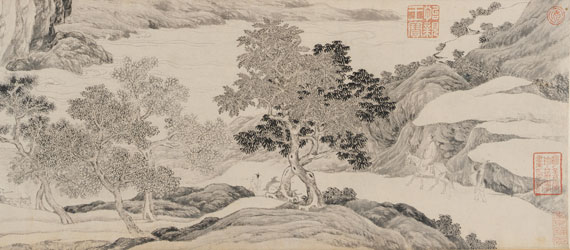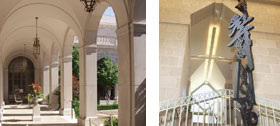
Above Right: The Southern Journey by Tang Yin. Learn more.
Freer Showcases "Masterpieces of Chinese Painting"
Song, Yuan, Ming and Qing Works Showcase Nine Centuries of Artistic Tradition
Media only: Megan Krefting 202-633-0271; kreftingm@si.edu
Public only: 202.633.1000
June 01, 2010
Twenty-seven iconic works of Chinese painting from the Freer's permanent collection will be on view June 12 – Nov. 28. "Masterpieces of Chinese Painting" offers an exquisite selection of rarely exhibited, light-sensitive works by well-known artists from the late 10th to the early 18th century.
"These paintings are masterpieces. Some represent the earliest dated work or only surviving format by some of the most famous artists in Chinese history," said Joseph Chang, associate curator of Chinese art and curator of the exhibition.
The paintings are arranged chronologically, with emphasis on the different schools of Chinese painting, and include works through the Song (960-1279), Yuan (1279-1368), Ming (1368-1644) and Qing (1644-1911) dynasties. The paintings portray traditional Chinese motifs, such as Buddhist subjects, human figures, landscapes, animals, flowers and ink bamboo.
The Freer's earliest Song painting, Bodhisattva Guanyin of the Water Moon, is on view in the first half of the exhibition. Dating from 968 A.D., the Buddhist painting depicts the bodhisattva of compassion and was among the first recovered from a cave in Dunhuang (present-day Gansu Province) in the early 20th century. Monumental hanging scrolls and intimate landscapes in album leaf format exemplify the misty, atmospheric approach of the Southern Song dynasty (1127-1279).
Well-known works by Yuan artists Qian Xuan (c. 1235-1307) and Wu Zhen (1280-1354) reflect Chinese art under Mongol rule.
In the Ming and Qing section of the exhibition, early Ming taste is reflected in the works of the professional Zhe school, which proffered landscapes of the hermit and scholar. During the middle of the Ming dynasty, Chinese painting underwent a significant shift due to the rise of the great artist, theorist and connoisseur Dong Qichang (1555-1636). Known for his theories on landscape painting, Qichang advanced the idea that modern Chinese painting should emulate past masters, as seen in his 1617 Landscape, which extols the literati (scholar-painters) of the Song and Yuan dynasties. Qichang's theory of lineage, tempered by his belief in the study of nature, was so influential, that "it still forms the basis for art historical analysis of Chinese landscape painting today," said Chang.
"Masterpieces of Chinese Paintings" will be on view in Gallery 13 of the Freer Gallery of Art.
For more information about the Freer and Sackler galleries and their exhibitions, programs and other events, the public is welcome to visit www.asia.si.edu. For general Smithsonian information, the public may call (202) 633-1000 or TTY (202) 633-5285.
The Freer Gallery of Art, located at 12th Street and Independence Avenue S.W., and the adjacent Arthur M. Sackler Gallery, located at 1050 Independence Avenue S.W., are on the National Mall in Washington, D.C. Hours are 10 a.m. to 5:30 p.m. every day, except Dec. 25, and admission is free. The galleries are located near the Smithsonian Metrorail station on the Blue and Orange lines.

Exhibition Information
Masterpieces of Chinese Painting
June 12–November 28, 2010Freer Gallery of Art
More info »
Contact us
pressasia@si.eduTel: 202.633.0271
Fax: 202.633.0046
Office of Marketing and Communications
Freer Gallery of Art and Arthur M. Sackler Gallery
PO Box 37012, MRC 707
Washington, DC 20013-7012
